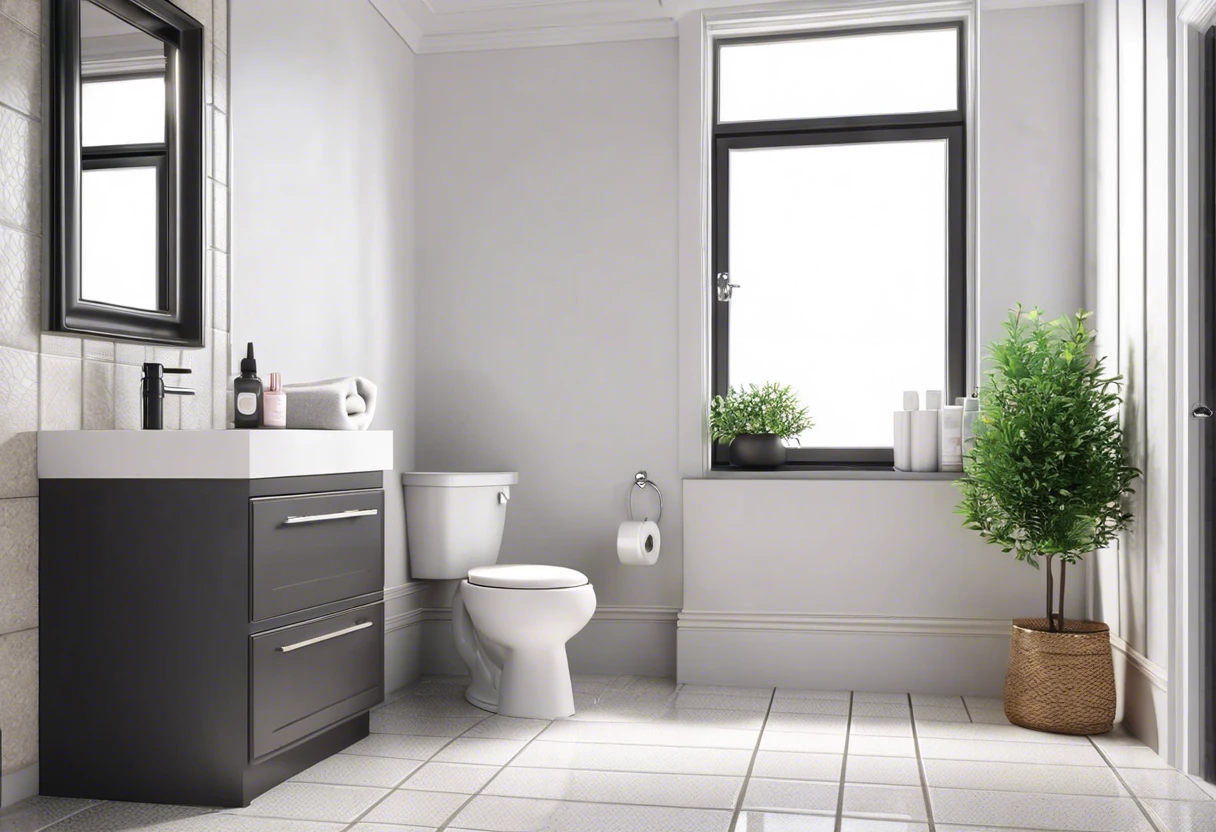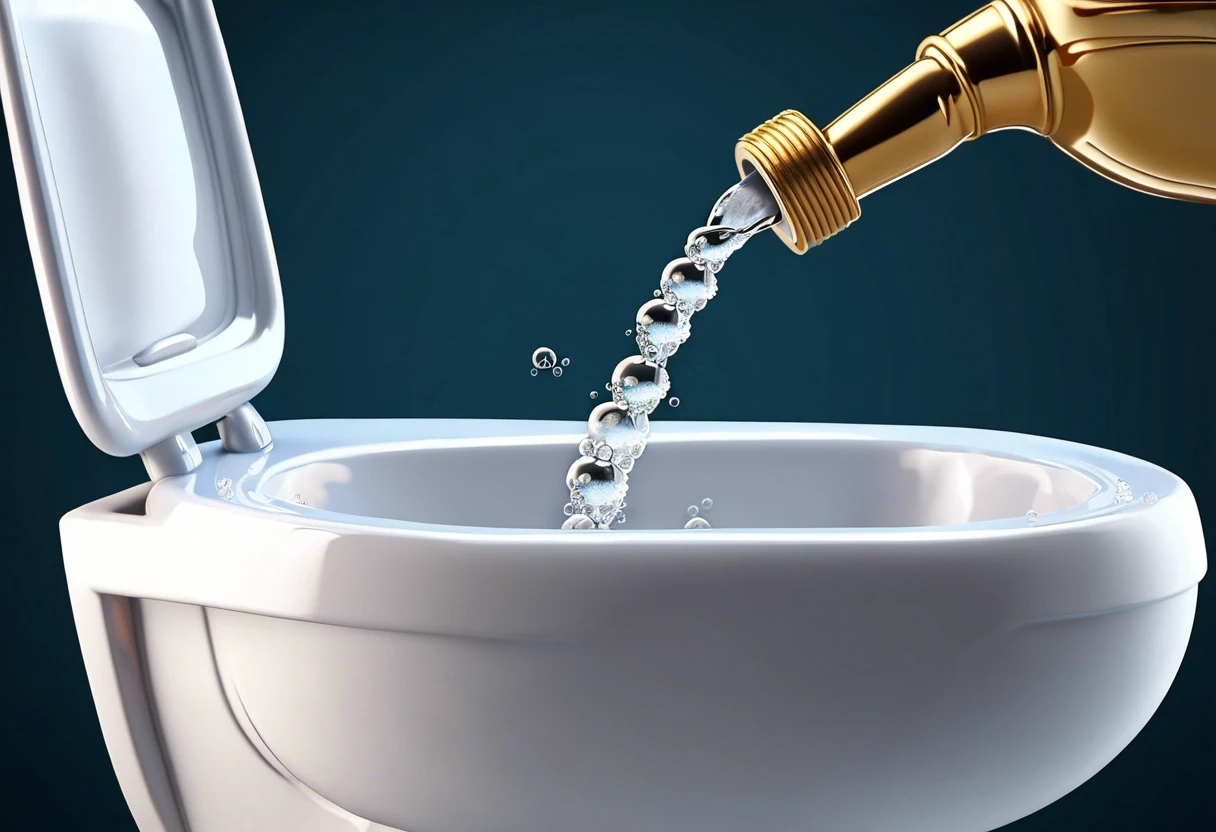Is Liquid Plumber Safe for Toilets?
Last Updated: February 27, 2025
Liquid Plumber is a special liquid that helps unclog sinks and drains. Think of it like magic juice that makes water flow again!
Over the years, one question that keeps coming up is, is liquid plumber safe for toilets? In my experience, I’ve seen it help and sometimes hurt, so I’m here to share my insights to help you understand better.
This article will cover what Liquid Plumber is, safety tips for toilet use, costs, factors influencing safety, special considerations for toilets, and when to reach out to a pro, among other things.
Table of Contents
- Is Liquid Plumber Safe for Toilets?
- What is Liquid Plumber?
- Before You Start Using Liquid Plumber…
- How to Use Liquid Plumber Safely in Your Toilet
- What Are the Factors Affecting the Safety Of Liquid Plumber for Toilets?
- Common Ingredients in Liquid Drain Cleaners and Their Impact on Toilets
- What Are Safe Alternatives to Liquid Plumber in Toilets?
- Special Considerations When Using Liquid Plumber in Toilets
- When to Contact a Professional Regarding Clogs and Liquid Plumber Usage
- Alternative Methods for Unclogging Toilets
- Common Misconceptions About Liquid Plumber Usage in Toilets
- Homeowners, It’s Time to Talk Toilets and Clogs
- Final Words on the Safety and Use Of Liquid Plumber for Toilets
- Useful References
Is Liquid Plumber Safe for Toilets?
No, using Liquid Plumber in toilets isn’t recommended. It can damage the porcelain and interfere with the plumbing. If you’re facing clogs, consider a plunger or specialized toilet-safe drain cleaner. Professional plumbers often suggest alternative methods for effective toilet maintenance and creating a strategic maintenance plan. Your toilet will thank you!
What is Liquid Plumber?
Liquid Plumber is a powerful drain cleaner designed to tackle tough clogs in sinks, showers, and bathtubs. This caustic mixture has one central formulation—sodium hydroxide (Naoh)—combined with other chemicals that break down organic materials. In fact, these types of products can raise the temperature of clogged water by approximately 20°F (11°C) to help dissolve syringes, hair fibers, and greasy residues. Given Orange County’s dry climate, regular usage can be important to maintain clear plumbing lines and avoid pesky backups that disrupt your daily routine! If you’re considering expanding your plumbing expertise, you might want to explore professional plumbing business opportunities.
I had a friend use it when they faced an absolutely atrocious blockage in their tub. Thankfully, they were cautious—or maybe just commonsensical—about using a liquid solution designed for drains and not toilets. While you might be stoked about quick fixes with Liquid Plumber, many warnings note that it’s not recommended for toilets because the solutions can damage plumbing components and the ceramic itself. Plus, local codes prohibit products like this in certain waterways, so it’s important to ensure you’re not contributing to environmental issues while unclogging drains—definitely something to think about! When stubborn clogs persist, professional drain snaking might be the most effective solution professional drain snaking techniques.
Before You Start Using Liquid Plumber…
What do you need to ensure a smooth unclogging process?
- Rubber Gloves: Grab gloves like the Farmed brand, designed for chemical resistance. They’re essential for protecting your hands from any harmful chemicals in Liquid Plumber.
- Plastic Funnel: Use a funnel like the OXO Good Grips brand for controlled pouring. It’s crucial because it helps prevent spills when you’re pouring the solution into the toilet.
- Measuring Cup: Get a measuring cup like the Pyrex Cookware 1-Cup measuring cup. You’ll need it to accurately measure out the Liquid Plumber for safe application in the toilet.
- Bathroom Bucket: A sturdy bucket, such as the Rubbermaid 5-Gallon bucket, is necessary. It helps gather waste or excess Liquid Plumber to avoid a mess.
- Cloth Rags: Clean up spills easily with regular cleaning cloths, preferably the Scotch-Brite brand. They make handling any mess created during your unclogging mission a breeze.
We’ve wrapped up important tips for using Liquid Plumber effectively. Let us turn our attention to safe usage in toilets.
Also See: How Long It Takes to Become a Plumber? A Quick Guide

How to Use Liquid Plumber Safely in Your Toilet
Let’s dive into the steps for using Liquid Plumber safely in your toilet—don’t skip these crucial steps!
-
Read the Instructions Carefully
Check the label on the Liquid Plumber bottle for specifics because each product varies. As someone who’s been knee-deep in plumbing for years, I can tell you that precise dosing instructions can make all the difference when dealing with tough clogs. Professional plumbers often recommend specific techniques for advanced drain maintenance strategies.
Make sure to pay attention to any warnings. It’s essential to know which materials to avoid mixing with Liquid Plumber to prevent damaging your plumbing.
-
Assess the Clog Type
Identify if your toilet is clogged due to waste buildup or non-flushable items. Liquid Plumber is powerful against organic clogs, but from my experience, it’s not as effective if your toilet’s stopped up because of foreign objects. Professional plumbers often encounter significant physical strain when addressing complex blockages challenging plumbing repair techniques.
If the toilet has a severe backup and you notice standing water, you may need a toilet auger instead. Trying to use Liquid Plumber in those situations could lead to worse problems, guaranteed. When dealing with complex plumbing issues, it’s crucial to know whether your water heater falls under plumbing or HVAC systems water heater system classification.
-
Wear Protective Gear
Before you start, put on gloves and eye protection. Remember, this alkaline chemical can be corrosive and cause harm, so it’s crucial to keep yourself protected during this process.
Don’t just flaunt the protective gear; use it diligently. Even splashes can lead to unpleasant experiences you want to avoid—trust me on that!
-
Apply the Product
Pour the recommended amount of Liquid Plumber into the toilet bowl, aiming directly over the clog. For most products, that’s typically around 2 to 4 cups (475 to 950 Ml), but be sure to check the label as mentioned earlier. When dealing with stubborn blockages, you might wonder about the effectiveness of different drain cleaning solutions comparing chemical drain cleaners.
Let it sit for 15 minutes to an hour depending on how bad the clog is—sometimes patience is key! My clients literally couldn’t believe how effective just waiting it out could be when done right.
-
Flush the Toilet
Once the time’s up, carefully flush your toilet. This step will help to fully dislodge whatever was blocking your pipes—the satisfaction of it flowing again is unrivaled!
If you still see leftover standing water after attempting to flush, don’t force it. You may need to repeat the previous steps and check for heavier clog concentrations.
Pro Tip: Avoid using Liquid Plumber more than twice a year in toilets to prevent possible damage; a more natural approach can work just as well!
We covered safe usage of Liquid Plumber in toilets. We will now cover factors influencing its safety for toilet use.
What Are the Factors Affecting the Safety Of Liquid Plumber for Toilets?
So, what factors determine whether Liquid Plumber is safe for your toilet?
-
Toilet Type: Modern toilets with fragile parts may get damaged by the strong chemicals found in Liquid Plumber.
-
Clog Type: Liquid Plumber works best on grease or hair clogs but can’t handle solid obstructions like toilet paper.
-
Pipe Composition: PVC pipes may react negatively to Liquid Plumber, causing more damage, especially in older homes in Irvine.
-
Local Codes: Some areas discourage using harsh chemical cleaners for toilets due to environmental concerns, particularly in the OC.
We covered the factors influencing the safety of Liquid Plumber for toilets. We will now cover the ingredients in drain cleaners and their effects.
Common Ingredients in Liquid Drain Cleaners and Their Impact on Toilets
Understanding what’s inside Liquid Plumber is crucial before deciding if it’s a suitable choice for your toilet.
| Ingredient | Function | Impact on Toilets |
|---|---|---|
| Sodium Hydroxide (Lye) | Breaks down organic matter. | Can damage porcelain and rubber components. |
| Potassium Hydroxide | Similar to sodium hydroxide, used for tough clogs. | Might corrode connections in older toilets. |
| Surfactants | Helps to dissolve grease. | Generally safe but can accumulate deposits over time. |
| Fragrance | Mask odors from clogs. | Usually harmless, but can cause issues if inhaled during use. |
| Colorants | Give the product its color. | No effects on plumbing but could stain. |
That covers common ingredients in liquid drain cleaners and their effects on toilets. Let’s now take a look at safe alternatives.

What Are Safe Alternatives to Liquid Plumber in Toilets?
Not feeling Liquid Plumber? Here are safe alternatives to tackle toilet clogs.
- Eco-friendly Enzyme Cleaners: These use natural enzymes to break down waste and are safe for pipes.
- Hot Water: A simple yet effective method! Pouring hot water can help dissolve light clogs.
- Baking Soda and Vinegar: This mixture creates a bubbly reaction that can break down sludge. Use 1 cup each!
- Manual Tools: A toilet auger can handle tough clogs without the risk of chemical damage.
- DIY Drain Snake: You can fashion a simple snake with a wire coat hanger to reach stubborn blockages.
Special Considerations When Using Liquid Plumber in Toilets
In this section, I’ll cover key technical factors you need to keep in mind when deciding if this product is right for your toilet.
- PVC Compatibility: Liquid Plumber’s harsh chemicals can corrode and damage PVC pipes, which are common in many Cali homes. Use it sparingly and consider alternatives.
- Heat Generation: When Liquid Plumber breaks down clogs, it generates heat. Monitor your toilet closely; excessive heat can crack porcelain.
- Clog Severity: For heavy clogs, you might need multiple treatments. Otherwise, you’re better off clearing them out by hand. It’s good to gauge how tough the problem is first.
- Clearance Areas: Ensure proper ventilation in the bathroom, as the chemicals can give off strong fumes. Always be cautious while using it in closed spaces.
- Adherence to Manufacturer’s Instructions: Follow the recommended usage on the product for safety—this usually suggests waiting at least 15 to 30 minutes before flushing.
When to Contact a Professional Regarding Clogs and Liquid Plumber Usage
Clogs can be hella annoying, right? Sometimes, it’s a DIY challenge. Other times, it’s time to call in a pro. Look for experts who are licensed and know the ins and outs of our Irvine plumbing system. Recommendations from friends or neighbors can help you find someone you can trust. When navigating complex plumbing issues, you might want to explore landlord plumbing responsibilities.
Listen, if a clog keeps coming back or your toilet gurgles like it’s auditioning for a horror movie, don’t mess around. Reach out to a plumbing expert. And just like I learned coming up through hands-on work, stay clear of unlicensed operators who don’t have insurance. Those guys can lead to even more problems than your clogged drain. If you’re wondering about the cost of specialized tools like a plumbing snake, renting equipment can be a smart option.
Alternative Methods for Unclogging Toilets
If Liquid Plumber isn’t your go-to, don’t worry! There are plenty of DIY alternatives and techniques to tackle toilet clogs safely.
- Plunger: A classic choice! Invest in a good quality flange plunger for toilets. It creates better suction and is hella effective for most clogs.
- Toilet Auger: This nifty tool tackles stubborn clogs. The metal coil can break down blockages deep in the pipe—perfect for those sneaky objects trapped out of reach!
- Hot Water: Sometimes, all you need is a good pour of hot water down the bowl. Just be careful with how hot—boiling water can crack porcelain toilets. Aim for around 140°F (60°C).
- Baking Soda and Vinegar: This combo can work magic! Pour a cup of baking soda in, followed by a cup of vinegar, and watch it fizz. Let it sit for about 30 minutes, then flush with hot water.
Common Misconceptions About Liquid Plumber Usage in Toilets
There’s a lot of chatter about Liquid Plumber, but not all of it is accurate. Let’s bust some myths!
- “It Can Fix Any Clog:” Not true! Liquid Plumber won’t help with solid obstructions. It’s best for organic material.
- “It’s Always Safe To Use:” Unfortunately, that’s a no-go! It can damage your toilet’s interior and pipes if used improperly or too often.
- “Any Drain Cleaner Works For Toilets:” Nope! Always check if the product is toilet-safe. Not all drain cleaners are designed for such delicate systems.
- “Professional Plumbers Use Liquid Plumber Regularly:” Most pros avoid it! They see firsthand how this chemical can wreak havoc over time.
Homeowners, It’s Time to Talk Toilets and Clogs
Let’s face it—nothing strikes fear into the hearts of Irvine homeowners like a clogged toilet. It’s the ultimate nightmare, right? Luckily, I’ve got your back with some solid tips and tricks.
First off, ever tried good old Liquid Plumber? It can work wonders for softening clogs caused by hair and toilet paper. But here’s a pro tip: wait about 15 minutes before you flush. You want that stuff to do its magic! When dealing with tougher blockages, you might need to rent a professional plumbing snake.
Is Liquid Plumber Effective for Clogs in Toilets?
You bet! Liquid Plumber can be effective for those annoying toilet clogs. Just make sure to follow the instructions—too much of a good thing can backfire.
Can Using Liquid Plumber Damage My Toilet?
Not if you stick to the directions! Sure, overdoing it can lead to some nasty surprises down the line, but used correctly, it’s fairly safe.
Are There Alternatives to Liquid Plumber for Toilet Clogs?
Absolutely! Depending on what you’re dealing with, you could whip out some baking soda and vinegar along with a trusty plunger. Seriously, those homemade remedies are classic for a reason!
Can I Use Liquid Plumber With Septic Systems?
Nah, steer clear if you’ve got a septic system. That harsh stuff can throw your system’s bacteria out of whack, and you really don’t want to deal with that headache.
What About Professional Help?
Sometimes, DIY isn’t the answer. If your toilet’s backed up beyond belief, it’s probably time to call in the pros. They have the tools and expertise to fix the issue without causing more damage. Professional plumbers develop specialized skills that make complex repairs look effortless, and if you’re curious about plumbing basics and DIY tips.
Do Plumbers Recommend Liquid Plumber?
Honestly, most plumbers don’t. They’d much rather see you using a plunger or a plumber’s snake. Less stress on your plumbing means fewer headaches later on!
So, if you ever find yourself facing a plumbing issue, just remember: you’ve got options! And if all else fails, don’t hesitate to reach out. I’m always here to help out my fellow Irvine neighbors. If you’re wondering about tackling plumbing repairs yourself, check out homeowner plumbing system replacement for expert guidance.
Final Words on the Safety and Use Of Liquid Plumber for Toilets
I hope this was worth your while as we’ve covered what Liquid Plumber is, before using it, safety guidelines, costs, factors affecting safety, special considerations, and when to reach out to a pro regarding clogs.
In conclusion, Liquid Plumber is not recommended for toilets, so proceed with caution. If you need assistance, feel free to reach out.
For more information, Irvine Plumbers can provide you with additional insights.
Useful References
- Is it safe to use a liquid plumber to unclog toilets? – Quora
- Can You Use Liquid Plumber in a Toilet? Expert Answers & Advice
- Maplewood Online – Do not use with plunger or in toilet — Liquid Plumber.


